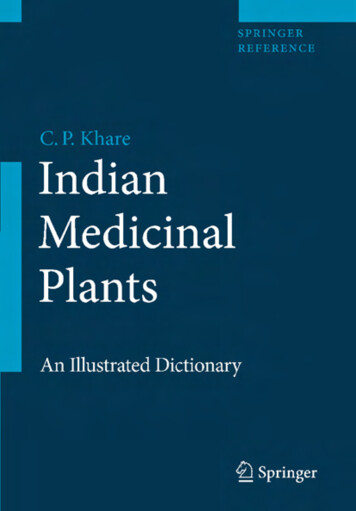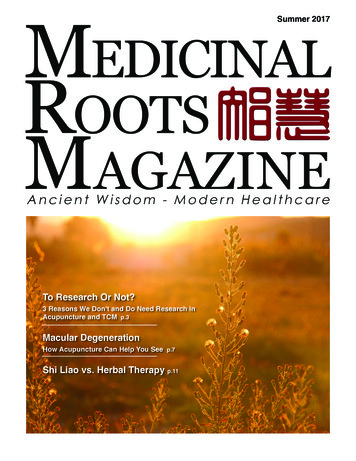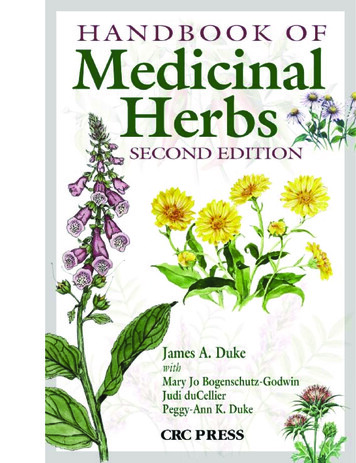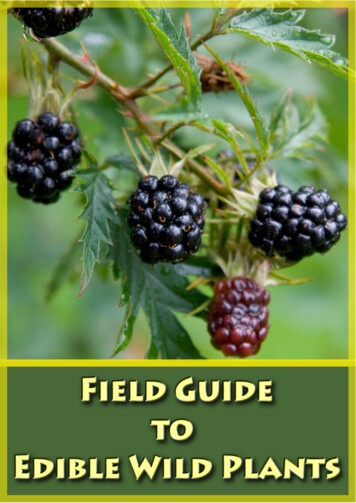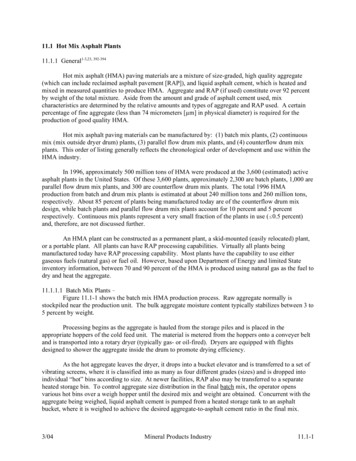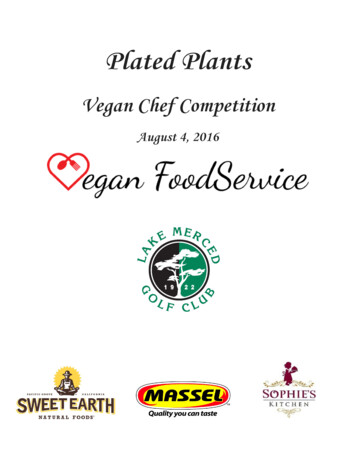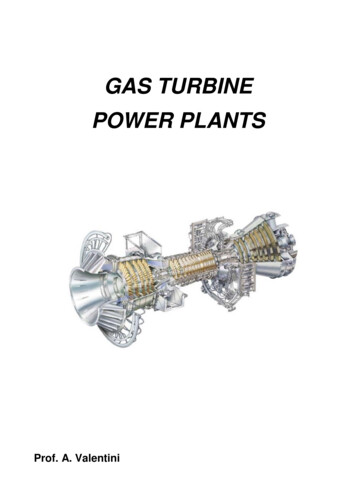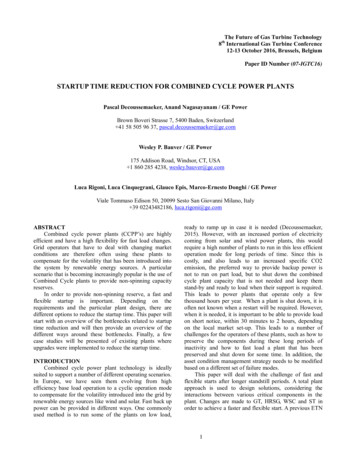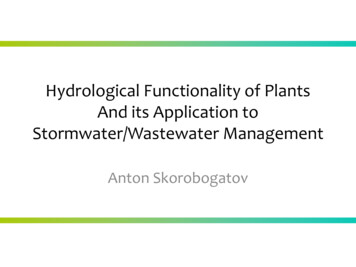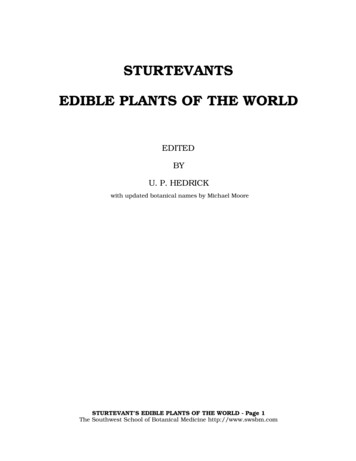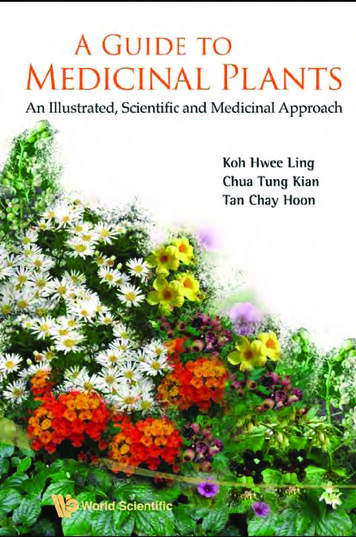
Transcription
A GUIDE TOMEDICINAL PLANTSAn Illustrated, Scientific and Medicinal ApproachKoh Hwee LingChua Tung Kia nTan Chay Hoon
A GUIDE TOMEDICINALPLANTSAn Illustrated, Scientific andMedicinal Approach
This page intentionally left blank
MEDICINAL PLANTSAn Illustrated, Scientific and Medicinal ApproachKoh Hwee LingNational University of Singapore, SingaporeChua Tung KianMinistry of Education, SingaporeTan Chay HoonNational University of Singapore, SingaporeOther contributors:Johannes Murti JayaSiah Kah YingChin Kar LingToh Ding FungChing JianhongLi LinPhotographers:Chua Tung KianKoh Hwee LingSiah Kah YingChing JianhongJohannes Murti Jaya
Published byWorld Scientific Publishing Co. Pte. Ltd.5 Toh Tuck Link, Singapore 596224USA office: 27 Warren Street, Suite 401-402, Hackensack, NJ 07601UK office: 57 Shelton Street, Covent Garden, London WC2H 9HEBritish Library Cataloguing-in-Publication DataA catalogue record for this book is available from the British Library.A GUIDE TO MEDICINAL PLANTSAn Illustrated, Scientific and Medicinal ApproachCopyright 2009 by World Scientific Publishing Co. Pte. Ltd.All rights reserved. This book, or parts thereof, may not be reproduced in any form or by any means,electronic or mechanical, including photocopying, recording or any information storage and retrievalsystem now known or to be invented, without written permission from the Publisher.For photocopying of material in this volume, please pay a copying fee through the CopyrightClearance Center, Inc., 222 Rosewood Drive, Danvers, MA 01923, USA. In this case permission tophotocopy is not required from the publisher.ISBN-13 978-981-283-709-7ISBN-10 981-283-709-4Typeset by Stallion PressEmail: enquiries@stallionpress.comPrinted in Singapore.Shelley - A Guide to Medicinal Plants.pmd15/8/2009, 6:12 PM
FADisclaimerThe contents of the book serve to provide both general and scientific information about medicinal plants and their uses and are not intended as a guide toself-medication by consumers or to treatment by health care professionals.The general public is advised to discuss the information contained hereinwith a physician, pharmacist, nurse or other authorised health care professionals. Neither the authors nor the publisher can be held responsible for theaccuracy of the information itself or the consequences from the use or misuseof the information in this book.The resources are not vetted and it is the reader’s responsibility to ensure theaccuracy of the information cited. Readers are reminded that the informationpresented is subject to change as research is on-going and there may beinterindividual variations. While every effort is made to minimise errors,there may be inadvertant omissions or human errors in compiling thesemonographs.vb716 FM.indd v1/8/2009 4:18:25 PM
FAThis page intentionally left blankvib716 FM.indd vi1/8/2009 4:18:25 PM
FAThis book is dedicated to our families for their supportand to our students who continue to inspire us!viib716 FM.indd vii1/8/2009 4:18:25 PM
FAThis page intentionally left blankviiib716 FM.indd viii1/8/2009 4:18:26 PM
FAForewordAt first glance, “A Guide to Medicinal Plants: An Illustrated, Scientific andMedicinal Approach” appears to be a medical compendium of plants intendedas a guide and reference resource for professionals in the field. To my delightand I am sure of anyone who picks up this book, I discovered it contains nuggets of information that would interest a great many readers, fromschoolchildren to teachers, from undergraduates to researchers, from homemakers to business people and of course, the healthcare professionals.It is an authoritative and well-researched work on seventy-five, mostly familiarplants that have medicinal value. These grow well here and in the tropics. Althoughthere have been books on medicinal plants published locally, none can match thiscomprehensive work which, as the authors state, is the first of its kind.It contains information in well laid-out sections that would interest thehealthcare professionals and at the same time, provide the general publicvaluable insights into the traditional use of plants as medicines. Today suchplants are being studied intensively to elucidate their bioactive compositionin the hope of discovering novel therapeutics and potential cures for majordiseases such as cancer and AIDS.This guidebook is user friendly. It provides the reader the ability to identify theseventy-five plants through their scientific, vernacular and common names aswell as through the descriptions and high quality photographs. Readers are alsofree to go straight to the section that interests them most. A strength of this bookis the detailed references provided for each plant and these are provided towardsthe end of the book for the serious reader or researcher.One word of caution that the authors themselves have provided in the text butis worth repeating. Do not mistake this scientific book for a do-it-yourselfmedication guide. As the authors aptly state, “the information collated is notmeant to be a guide for self medication by consumers or for treatment byhealthcare professionals.”I commend the authors for this labour of love and have no doubt that this bookwill be much sought after by both the healthcare professionals and the lay public.Professor Leo Tan Wee-HinPresidentSingapore National Academy of Scienceixb716 FM.indd ix1/8/2009 4:18:26 PM
FAThis page intentionally left blankxb716 FM.indd x1/8/2009 4:18:26 PM
FAPreface“All things are poison and nothing is without poison, only the dosepermits something not to be poisonous” i.e., “the dose makes thepoison”.ParacelsusThis book presents up-to-date information on a total of 75 medicinal plants. It isa single, comprehensive yet easy to read book on various important informationon medicinal plants for both the general public and health professionals(clinicians, pharmacists, nurses and Complementary and Alternative Medicinepractitioners).This is the first publication of its kind on medicinal plants growing inSingapore. Information collated includes plant description, origin of theplants, traditional medicinal uses, phytoconstituents, pharmacological activities, adverse reactions and reported drug-herb interactions. In this era ofevidence-based medicine, scientists are increasingly looking towards thetraditional uses of medicinal plants for clues to the discovery of potentiallead compounds and novel therapeutics.With the growing interest in drug discovery, this book is useful and timely asmany of the plants found growing in Singapore are still understudied. Besidesnative medicinal plants, some of the plants featured in this book also includethose that originated from other parts of the world. It will appeal to both localand overseas readers. Colourful photographs of each plant are also includedfor ease of reference and aesthetic appeal. There is no minimum level ofknowledge required to read this book yet it is useful for academics, scientistsand professionals as it provides a comprehensive reference list at the end ofthe book. This book will also appeal to working professionals, clinicians,pharmacists, nurses, educators and researchers. It serves as a quick referenceto the medicinal uses and properties of medicinal plants. Educators and students in complementary medicine and health, pharmacognosy, medicinalchemistry, natural products, pharmacology, toxicology, pharmacovigilance,medicine, pharmacy, nursing, botany, biology, chemistry and life sciencesxib716 FM.indd xi1/8/2009 4:18:26 PM
FAxiiA Guide to Medicinal Plantswill find the information useful. Greater understanding of such plants willenhance their appreciation of nature and their various fields of study.The authors hope that this book will inspire and stimulate further researchand greater interest in nature, biodiversity, bioconservation, drug discoveryand our natural resources, the medicinal plants.b716 FM.indd xii1/8/2009 4:18:26 PM
FAGuide to Using This BookThis book is intended for both the general public as well as health professionals. Hence, it is quite a challenge to present the vast amount of informationcollated from published literature over the years, in a simple way that willbenefit and interest different groups of readers. In general, the informationpresented is fully referenced. Wherever possible, the original terms in thereferences are used. Difficult botanical and medical terms are explained insimple terms in the glossaries provided.Monographs of the plants are arranged in alphabetical order of the Latinbinomial name. Each monograph consists of information which includes thescientific name with the family name in parenthesis, common name(s), coloured photographs, description, origin, phytoconstituents, traditionalmedicinal uses, pharmacological activities, dosage (if available), adversereactions, toxicity and reported drug-herb interactions. Authors’ notes areadded in some cases as well. Cross listings of the scientific names and commonnames, and vice versa, are provided in the appendix for easy reference.Traditional medicinal uses refer to those uses that have been reported andmay not have been studied scientifically. Pharmacological activities refer tothe biological activities that have been reported in scientific publicationsinvolving mainly in vitro or in vivo tests using animals, and very rarely, inclinical trials. Activities due to extracts as well as pure components arereported. Due to space constraints, only the keywords are given. Interestedreaders can refer to the original publications for more details. The full list ofreferences is provided at the end of the book according to the plant names inalphabetical order.“No information as yet” means that no such information is available, theauthors have not found the relevant information, or the information foundis not cited due to lack of clarity or completeness. A word of caution:although some dosages have been reported and cited, these have largelynot been verified in clinical trials. For phytoconstituents, it is not possibleto list down all reported constituents. Hence only selected constituents,especially those peculiar to the plant are shown, typically with the mostimportant ones listed first. Interested readers can refer to the referencescited for further details.xiiib716 FM.indd xiii1/8/2009 4:18:26 PM
FAxivA Guide to Medicinal PlantsAlthough medicinal plants are generally safe when used appropriatelyaccording to the traditional methods, some are inherently toxic. In addition,inappropriate use (wrong plant parts, dose, frequency, route of administration, preparation, etc.) or abuse may lead to undesirable consequences. Theinformation collated is not meant to be a guide for self medication by consumers or for treatment by health care professionals. There is a fine linebetween a poison and a useful drug afterall.b716 FM.indd xiv1/8/2009 4:18:26 PM
FAAcknowledgementThe authors would like to express our heartfelt gratitude to:Professor Wee Yeow Chin for his professional advice and constructivecriticismsProfessor Ben-Erik van Wyk, Professor Zhao Zhong Zhen and ProfessorHugh Tan for their professional adviceStaff and students who have contributed to this bookThe National University of Singapore for financial support of an AcademicResearch Fund (R-148-000-079-112)Staff of Nparks (Singapore) and Singapore Botanic Gardens, especiallyProfessor Benito Tan, Mr Lua Hock Keong, Ms Serena Lee, Ms Patricia Yapand the park rangersStaff of Singapore Science CentreMany like-minded friends and colleagues for their interesting and inspiringdiscussions on medicinal plantsStaff of World Scientific Publishing for their professionalism and supportxvb716 FM.indd xv1/8/2009 4:18:26 PM
FAThis page intentionally left blankxvib716 FM.indd xvi1/8/2009 4:18:26 PM
FAContentsAuthors and Contributors . . . . . . . . . . . . . . . . . . . . . . . . . . . . . . . . . . . . . . . iiiDisclaimer . . . . . . . . . . . . . . . . . . . . . . . . . . . . . . . . . . . . . . . . . . . . . . . . . . . vForeword . . . . . . . . . . . . . . . . . . . . . . . . . . . . . . . . . . . . . . . . . . . . . . . . . . . . ixPreface. . . . . . . . . . . . . . . . . . . . . . . . . . . . . . . . . . . . . . . . . . . . . . . . . . . . . . xiGuide to Using This Book . . . . . . . . . . . . . . . . . . . . . . . . . . . . . . . . . . . . . xiiiAcknowledgement . . . . . . . . . . . . . . . . . . . . . . . . . . . . . . . . . . . . . . . . . . . .xvPlant Monographs. . . . . . . . . . . . . . . . . . . . . . . . . . . . . . . . . . . . . . . . . . . . 20.21.Abrus precatorius L. (Leguminosae) . . . . . . . . . . . . . . . . . . . . . . . . . .2Adiantum capillus-veneris L. (Polypodiaceae) . . . . . . . . . . . . . . . . . .4Allamanda cathartica L. (Apocynaceae) . . . . . . . . . . . . . . . . . . . . . . .6Aloe vera Mill. (Aloaceae) . . . . . . . . . . . . . . . . . . . . . . . . . . . . . . . . . .8Andrographis paniculata (Barm.f.) Nees (Acanthaceae). . . . . . . . . .11Ardisia elliptica Thunb. (Myrsinaceae). . . . . . . . . . . . . . . . . . . . . . . .13Areca catechu L. (Palmae) . . . . . . . . . . . . . . . . . . . . . . . . . . . . . . . . .15Asplenium nidus L. (Aspleniaceae) . . . . . . . . . . . . . . . . . . . . . . . . . .18Aster tataricus L.f. (Compositae) . . . . . . . . . . . . . . . . . . . . . . . . . . . .20Azadirachta indica A. Juss. (Meliaceae) . . . . . . . . . . . . . . . . . . . . . .22Barringtonia asiatica L. (Lecythidaceae) . . . . . . . . . . . . . . . . . . . . . .24Barringtonia racemosa (L.) K. Spreng (Lecythidaceae) . . . . . . . . . .26Bauhinia purpurea L. (Leguminosae) . . . . . . . . . . . . . . . . . . . . . . . .28Bixa orellana L. (Bixaceae) . . . . . . . . . . . . . . . . . . . . . . . . . . . . . . . .30Calophyllum inophyllum L. (Guttiferae) . . . . . . . . . . . . . . . . . . . . . .32Cananga odorata (Lam.)
plants are being studied intensively to elucidate their bioactive composition in the hope of discovering novel therapeutics and potential cures for major diseases such as cancer and AIDS. This guidebook is user friendly. It provides the reader the ability to identify the seventy-five plants through their scientific, vernacular and common names as
